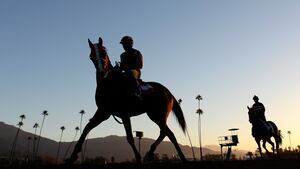Nearly three months after the Los Angeles District Attorney’s Office released a brief and chart-heavy report that found no evidence of misconduct in a cluster of horse deaths at Santa Anita Park in Los Angeles, the California Horse Racing Board has published a study of their own that clashes with those conclusions.
The 77-page report—nearly five times as long as the D.A.’s and with a fraction of the pictures—described a climate of “cumbersome, disorganized, and often incoherent” record-keeping, a pervasive sense of pressure to race horses, a lack of understanding among horsemen about “basic anatomy,”and several violations of CHRB policy that will result in at least 10 complaints filed against trainers and veterinarians.
Seven of the complaints involve violations of duties pertaining to veterinary records. Three involve training issues, including training without the proper license, and another concerns the unsanctioned administration of a therapeutic medication. A spokesperson for the track did not immediately respond to requests for further information about the complaints.
The results of the investigation come just a day after federal prosecutors in New York unsealed four indictments charging 27 trainers, veterinarians, and drug distributors in what they described as a “widespread corrupt scheme” to dope horses and cheat the $100 billion global industry.
California Horse Racing Board Executive Director Rick Baedeker began a press conference about the report by acknowledging the indictments. Although no California-based trainers were named in the complaints, and California was not listed as a location of the alleged doping, the CHRB has opened an investigation into the allegations.
The board retains post-race urine samples for two years, and plans to test them retroactively. “We have begun an investigation into the charges that were in that report,” Baedeker said. “We will not have any comments until that investigation is completed.”
The board’s findings concern a cluster of horse deaths that occurred at Santa Anita Park last spring. The mysterious breakdowns sent the horse racing industry into unprecedented self-reflection and drew media attention from publications across the country, including The Daily Beast, which published an investigation into the deaths over the weekend. The report confirms several key details of The Daily Beast’s reporting, including the widespread charges of pressure to race, the role of pre-existing injuries and unusual weather, breeding problems brought on by the commercialization of racing, and the use of therapeutic medications.
Although 38 horses died at the track last year, the study focused on the 23 fatalities that took place between Dec. 26, 2018, and March 31, 2019. Of those 23, 21 horses had a pre-existing pathology before they broke down; 19 had sesamoid bone—two small bones embedded in tendons behind the fetlock—fractures related to racing and training intensity; 11 had corticosteroid injections in one of their joints; and 39 percent occurred on surfaces impacted by California’s unusually heavy rain. Sixteen of the fatally injured horses had been under the care of trainers with at least one other fatality within a 12-month period—two of those trainers had multiple fatalities within the cluster, and a third had a second fatality later that spring.
A major focus in the report was the perception of pressure on trainers and jockeys to race horses, even under bad weather conditions or injury. It highlighted the efforts of Tim Ritvo, former chief operating officer of the track’s parent company, The Stronach Group, to increase field sizes and horsemen participation in racing—which are correlated with a larger handle—to improve the business.
“Tim Ritvo, who oversaw increases in horsemen’s participation and field sizes at TSG tracks in Maryland and Florida, repeatedly and openly expressed his intention to do the same at Santa Anita when he arrived in 2017,” the report said. “Shortly after arriving in California and becoming chief operating officer at Santa Anita, Ritvo told the Los Angeles Times that ‘we need to correct the guys who are here and not running and just using the place as a training track...We need to replace them.’”
Multiple trainers told investigators that the “the need to run more races with more starters may have contributed to a feeling on the part of trainers that if they didn’t run their horses, they could lose their allocation of stalls.” This echoes a finding in The Daily Beast’s investigation, that the track had tried to implement a stall fee, requiring trainers to race their horses a set minimum of days or pay a fine for every time they didn’t. After pushback from the trainer’s association, the fine never materialized.
The trainers also described a pressure from management to run their horses, though only one gave a specific example—recalling how he had been scolded by the racing secretary for entering a horse as “turf only,” meaning the horse would be automatically withdrawn or “scratched” if bad weather led management to hold the race on a different track surface. The Daily Beast’s investigation found seven trainers who cited concrete incidents, and more than a dozen others who shared the sentiment.
Across several areas of inquiry, the CHRB report described a pattern of negligent record-keeping. Data on track maintenance was described as “cumbersome, disorganized, and often incoherent.”
Confidential medical documents subpoenaed by the board revealed cases of “simply poor veterinary medical record keeping.” Likewise, the majority of the horsemen interviewed “did not review the necropsy reports on their horses,” and “did not display good working knowledge of anatomy or grasp the significance of major pre-existing lesions.”
“One of the most disappointing aspects of this process is how few trainers have reviewed their necropsy reports prior to sitting down and going through them,” said Dr. Rick Arthur, a regulator veterinarian with the CHRB and Equine Medical Director of the U.C. Davis School of Veterinary Medicine, during the press conference. “Part and parcel of that is a real lack of understanding of basic horse anatomy. Anatomy will be a key component of the continuing education process going forward.”
The report included a list of 47 reform recommendations, establishing firmer protocols for racing, training, and cancellations, and vigilant record keeping standards. “The California Horse Racing Board’s investigation into the horse deaths at Santa Anita Park makes it clear that more transparency is desperately needed in the sport,” California Senator Diane Feinstein said in a statement. “If the last year has taught us anything, it’s that we can no longer ignore the problems associated with horse racing. We must take action.”







